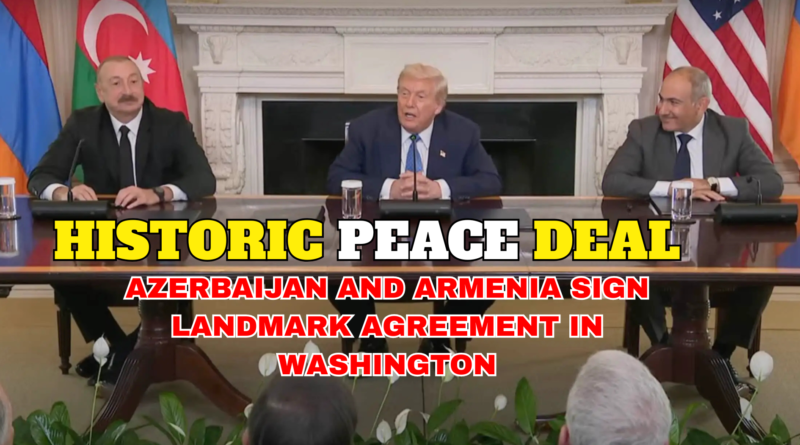AZERBAIJAN & ARMENIA SEAL U.S.-BROKERED PEACE DEAL
In a landmark diplomatic breakthrough, Azerbaijan and Armenia have signed a historic peace agreement in Washington, D.C., signaling a potential end to decades of hostility between the two South Caucasus nations. The accord, sponsored by the United States and mediated personally by President Donald Trump, marks one of the most significant steps towards stability in the region since the collapse of the Soviet Union.
The deal was finalized following several days of intensive negotiations at the White House, with U.S. Secretary of State and senior diplomatic advisors playing a pivotal role in bridging lingering divisions. Representatives from both Baku and Yerevan hailed the agreement as a “turning point” that could lay the groundwork for long-term coexistence, economic cooperation, and mutual security.
A Conflict Years in the Making
Relations between Azerbaijan and Armenia have been marred by bitter disputes, primarily over the Nagorno-Karabakh region a mountainous enclave internationally recognized as part of Azerbaijan but historically populated and governed by ethnic Armenians. The conflict erupted into full-scale war in the late 1980s and early 1990s, leaving tens of thousands dead and displacing hundreds of thousands from their homes.
Despite intermittent ceasefires brokered over the years, violence has repeatedly flared, most notably in 2016 and again in 2020, when a six-week war resulted in thousands of casualties and significant territorial shifts.
The deep mistrust between the two sides has long stymied diplomatic efforts. Previous attempts by the OSCE Minsk Group and other international mediators had failed to produce a lasting settlement.
Washington Steps In
The United States’ decision to take a more direct role in mediating the peace process represents a strategic shift in American foreign policy towards the Caucasus region. President Trump, framing the deal as a testament to his administration’s diplomatic prowess, described it as “a model for how even the most entrenched disputes can be resolved when both sides choose peace over conflict.”
According to White House sources, the negotiations addressed three major pillars:
Security Guarantees A commitment from both sides to refrain from the use of force, supported by international monitoring.
Territorial Understanding – Recognition of current boundaries with provisions for joint administration of certain contested zones.
Economic Cooperation – Agreements on trade, infrastructure development, and cross-border transport corridors.
The U.S. has pledged substantial economic aid to support post-conflict reconstruction and humanitarian initiatives in both countries.
Regional and Global Reaction
The peace agreement has been welcomed by key regional players and international bodies. The European Union praised the U.S. initiative, noting that stability in the Caucasus is crucial for energy transit routes that connect Central Asia to Europe. Russia, historically a dominant influence in the region, expressed cautious optimism, stating that it hoped the deal would complement rather than compete with its own peacekeeping efforts.
Turkey, a close ally of Azerbaijan, hailed the agreement as a “historic achievement,” while Iran emphasized its interest in maintaining open communication channels with both neighbors.
Challenges Ahead
While the agreement represents a major step forward, analysts caution that its success will depend heavily on implementation and sustained trust-building. Key issues including the status of displaced persons, cultural heritage protections, and long-term governance of contested territories will require ongoing dialogue.
Civil society groups in both countries have voiced support but also called for transparency in how the deal will affect ordinary citizens. Economic integration, many say, will be the true test of whether peace can hold beyond political promises.
A New Chapter in the Caucasus?
For the people of Azerbaijan and Armenia, the deal offers a rare moment of hope after decades of hostility. Families divided by frontlines may soon have opportunities to reunite. Trade routes long closed by conflict could reopen, fostering prosperity across the region.
If successfully implemented, this U.S.-brokered agreement could serve as a blueprint for resolving other entrenched conflicts worldwide. But for now, its most immediate promise is the chance for two nations and their people to imagine a shared, peaceful future.




